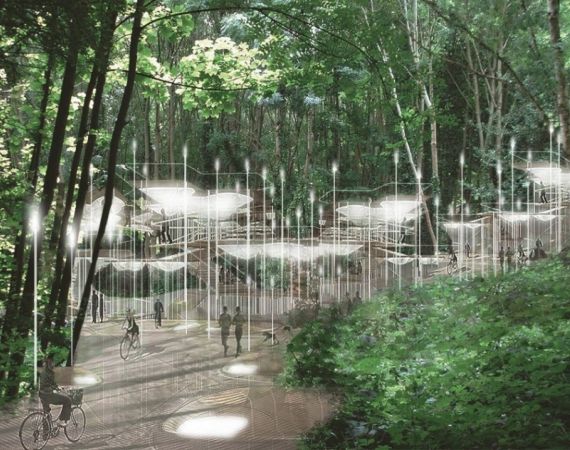Lunchtime talk write-up
Posted on Tue 2 Aug 2016
Designing our Future Cemeteries: From Biomass to Light
University of Bath’s Centre for Death and Society and the Future Cemetery ran a design competition for creatives to reimagine the future of cemeteries, in partnership with Arnos Vale Cemetery in Bristol.

Sylvan Constellations by DeathLAB and LATENT Productions
Speakers
Galen Pardee: DeathLAB Research Associate, Columbia University GSAPP
John Troyer: Bath University
Jeremy Routledge: Calling The Shots
University of Bath’s Centre for Death and Society and the Future Cemetery ran a design competition for creatives to reimagine the future of cemeteries, in partnership with Arnos Vale Cemetery in Bristol. The winning design 'Sylvan Constellation' draws on unique architectural design and innovative technological solutions to decomposition, developed by a team from Columbia University’s DeathLAB in New York together with LATENT Productions. For this Lunchtime Talk, we were joined by John Troyer, Director of the Centre for Death and Society and Galen Pardee, Research Associate at DeathLAB. Here are five things I learned:
1. With an increasingly aging and growing population, we are forever running out of space in urban cemeteries across the globe. The disposal and memorial of human remains is a complex issue with multifaceted considerations including religion, cultural practices and environmental impact. In New York there is an average of six deaths per hour, equating to 51,840 deaths every year. In such a high-density urban environment space is at a premium and burial is not a sustainable option.
2. The environmental impact of the funeral industry is relatively small but generally unaddressed. Galen shared some figures:
- The United States use 827,060 Gallons of embalming fluid every year
- In 2013, cremations in India and Nepal were responsible for nearly one quarter of national carbon emissions
- Cremating a body takes 2-3 hours at 1,500 Fahrenheit
There are some more environmentally friendly, but currently less common alternatives for disposal. One option is alkaline hydrolysis, which produces less carbon dioxide and pollutants than cremation and another option is promession, which involves freeze-drying.
3. ‘Sylvan Constellation’ reimagines the old orchard space at Arnos Vale Cemetery. The design incorporates discreet memorial vessels into a canopy interwoven with the existing forest-scape. The canopy will hold 150 vessels each housing one body and serving as an individual memorial for bereaved families and friends.
4. The 'Sylvan Constellation' design works on a cyclical process; as the course of decay occurs, bio-energy will fuel a memorial light. When the light dims and eventually goes out, the decomposition process has been completed. The remains will be returned to the family and the vessel can be reused. The process will take anytime from six months to a year.
5. DeathLAB is developing the design and technology behind their concept. The team is planning an exhibition for 'Sylvan Constellation' for Autumn 2016. To make this a reality there are many design considerations to engage, but primarily the team is interested in how we can reshape our relationship to death and rejuvenate and reimagine the use of urban public cemeteries.
The whole audience was interested in the design concept and decomposition process of 'Sylvan Constellation', and the talk triggered a rich conversation about the sustainability and future of human rituals around death.